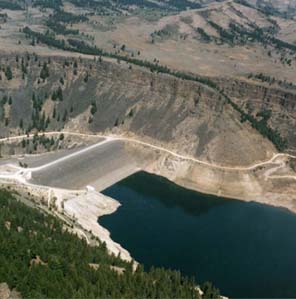
At 456 feet high, Anderson Ranch Dam was the highest embankment dam in the world when it was completed on Idaho’s Boise River in 1951. That happy day was slow in coming because builders found themselves in the middle of a World War II labor shortage and questions about the nation’s racial exclusions.
Work on Anderson Ranch Dam hardly had begun in 1941 when Japanese war planes bombed Pearl Harbor, launching America into the world war and intensifying hostility toward Japanese Americans. As wartime hysteria mounted, President Franklin D. Roosevelt signed Executive Order 9066, which forced more than 120,000 persons of Japanese ancestry living mostly on the West Coast to leave their lives behind and move inland to one of ten relocation centers.
In Idaho, the Minidoka Relocation Center was located on Bureau of Reclamation land at Hunt, in Jerome County, just 65 miles southeast of the Anderson Ranch Dam construction site. As the first Japanese-American evacuees arrived at Minidoka on August 10, 1942, workers at Anderson Ranch were busily excavating the 200-foot-wide cutoff trench, which would be filled with impervious materials to form a watertight foundation and help anchor the dam in place.
The dam contractor, facing a manpower shortage as more and more men joined the military, recognized a solution to his problem: the nearby Minidoka Relocation Center, where Japanese Americans were arriving at the rate of 500 a day. By September 14, 1942, a total of 8,381 internees were at the Relocation Center, many of whom went to work. During the fall of 1942, nearly 2,500 internees helped Idaho farmers in their fields while others stayed in camp, performing whatever labor the Morrison-Knudson Company needed to finish building Minidoka. Still other Japanese Americans were enlisted to work on Anderson Ranch Dam, which was being built by a joint venture of four companies, including Morrison-Knudson.
The use of Japanese-American labor raised significant issues because the Reclamation Act of 1902, which committed the Federal Government to build irrigation dams in 16 western states and territories, stipulated that “no Mongolian labor shall be employed.” Since its formation in 1902, the Bureau of Reclamation, created to administer the Reclamation Act, “had held fast to this racial exclusion labor policy.” It was, as historian William D. Rowley writes, “an iron-fast rule until labor shortages during World War II forced a change.” In 1943, Congress changed the law specifically so that Japanese-American internees could work on Reclamation projects.

Manpower was not the only wartime shortage to have an impact on Anderson Ranch Dam. A scarcity of building materials led the Federal Government’s War Production Board, which allocated materials and fuel during the war, to halt work on the dam the day after Christmas of 1942. Construction resumed on October 6, 1943, as part of the War Food Program; completion of Anderson Ranch Dam would mean more water for irrigation, and irrigation meant greater production from Boise Valley farms.
Constructing an embankment dam to such an unprecedented height presented many challenges, from locating sufficient embankment materials near the dam site to dealing with several rock slides. Nothing came easily. In addition to wartime delays and shortages, a complicated geology forced changes in design, and rock slides plagued the project. One slide in May 1943 dumped 20,000 cubic yards of rock into a tunnel at the intake portal. Another slide, however, turned out to be a boon, providing excellent embankment material and eliminating the need to haul material from farther away. Embankment dams are made of earth and rock and rely on their heavy weight, as well as a dense, waterproof core to prevent seepage and hold back the force of the water stored behind them. In addition to the dam core, a cement grout curtain helps control the flow of water through the foundation under the dam.

Work on the dam stopped again in early 1948 when funds dried up as Congress reduced public works projects. Construction started up again that April with a bid awarded to J.A. Terteling and Sons Inc. of nearby Boise. The company completed the crest, riprap, spillway, and outlet works and also built the Anderson Ranch Dam Powerplant, most of which was finished by early 1950, although the plant’s two generators were not totally installed and tested until 1951. The powerplant produced hydroelectric power, not only for regional industries and towns, but to power irrigation loads in southern Idaho and eastern Oregon. These units were up-dated in 1986, increasing their combined capacity from 27,000 kilowatts to 40,000 kilowatts. Anderson Ranch Dam, on the south fork of the Boise River, 42 miles upstream from historic Arrowrock Dam, adds storage for irrigation on the Boise Project, reduces damage from silt buildup, and protects the Boise Valley from floods.
Visit the National Park Service Travel Bureau of Reclamation's Historic Water Projects to learn more about dams and powerplants.
Last updated: January 13, 2017
